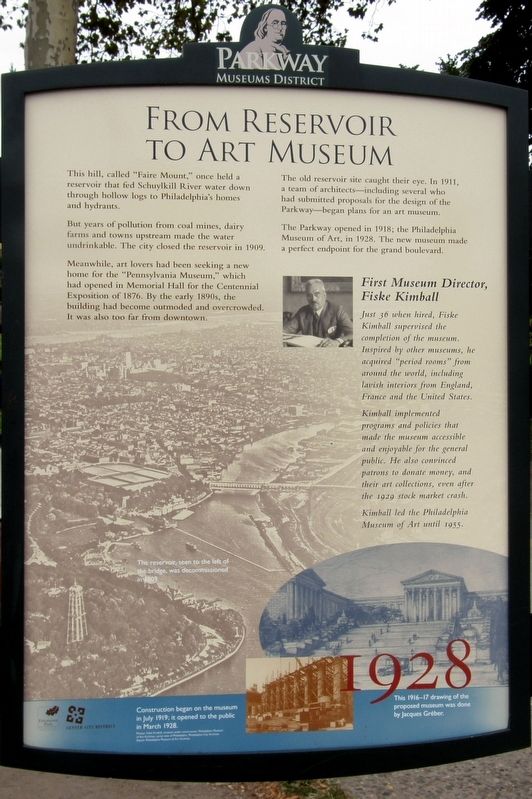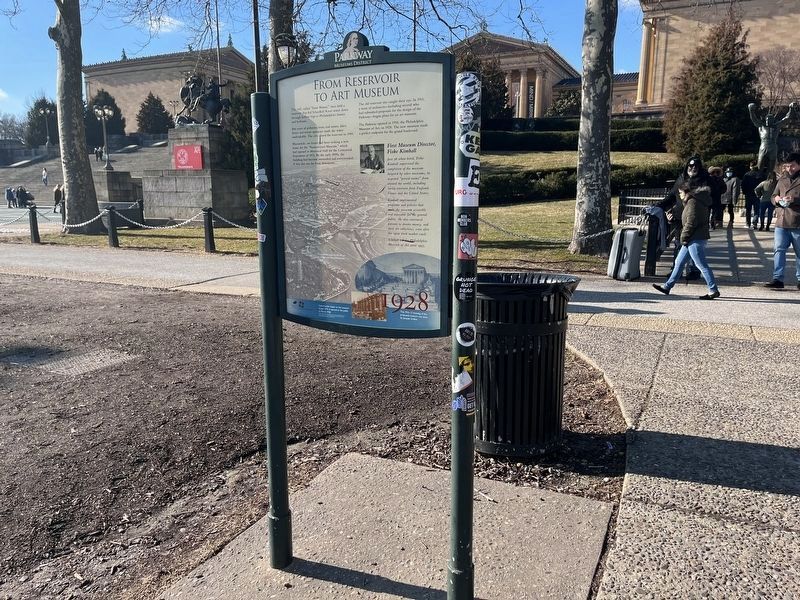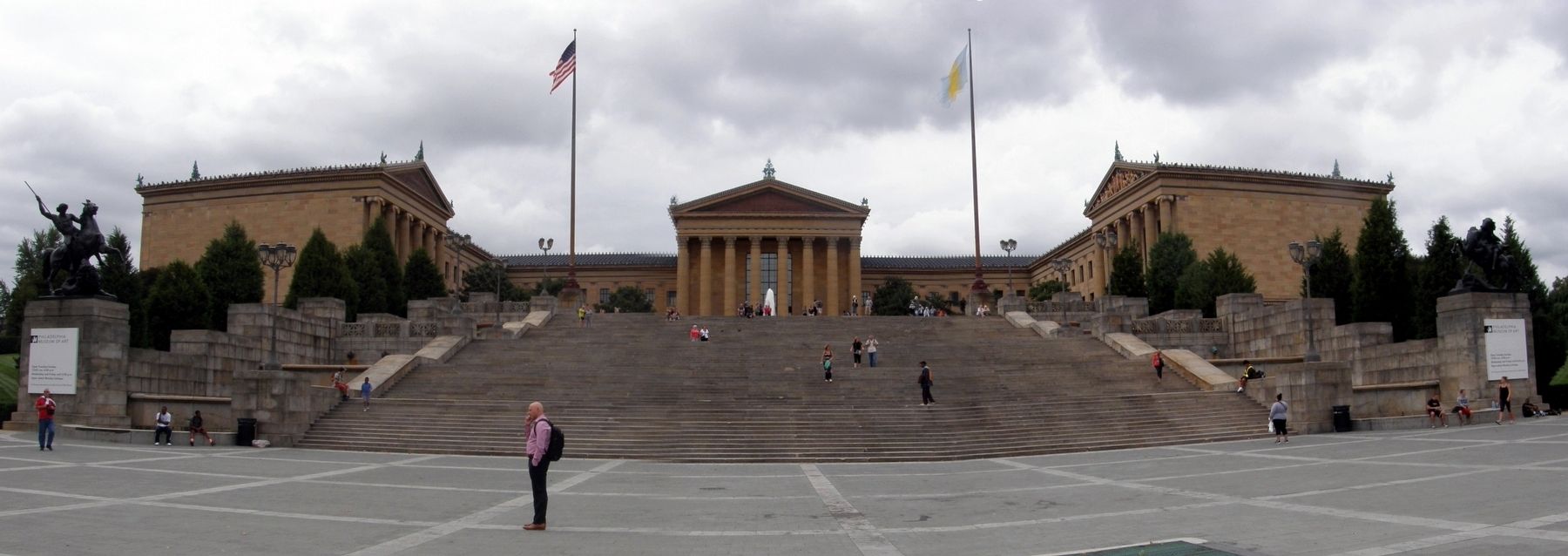Logan Square in Philadelphia in Philadelphia County, Pennsylvania — The American Northeast (Mid-Atlantic)
From Reservoir to Art Museum / Parkway Museums District
From Reservoir to Art Museum
1928
This hill, called “Faire Mount”, once held a reservoir that fed Schuylkill River water down through hollow logs to Philadelphia’s homes and hydrants.
But years of pollution from coal mines, dairy farms and towns upstream made the water undrinkable. The city closed the reservoir in 1909.
Meanwhile, art lovers had been seeking a new home for the “Pennsylvania Museum”, which had opened in Memorial Hall for the Centennial Exposition of 1876. By the early 1890s, the building had become outmoded and overcrowded. It was also too far from downtown.
The old reservoir caught their eye. In 1911, a team of architects – including several who had submitted proposals for the design of the Parkway – began plans for an art museum.
The Parkway opened in 1918; The Philadelphia Museum of art, in 1928. The new museum made a perfect endpoint for the grand boulevard.
First Museum Director, Fiske Kimball
Just 36 when hired, Fiske Kimball supervised the completion of the museum. Inspired by other museums, he acquired “period rooms” from around the world, including lavish interiors from England, France and the United States.
Kimball implemented programs and policies that made the museum accessible and enjoyable for the general public. He also convinced patrons to donate money, and their art collections, even after the 1929 stock market crash.
Kimball led the Philadelphia Museum of Art until 1955.
Parkway Museums District
❶ Boathouse Row
This picturesque collection of historic buildings comprises an important center of the United States’ rowing community. The boathouse shelters the sculls (boats) of local clubs, high school and college programs. The “Schuylkill Navy” hosts several major rowing regattas every year including the Dad Vail and the Head of the Schuylkill.
❷ Fairmount Water Works
This collection of Classical buildings was built between 1819 and 1822 to provide fresh drinking water to the City. The first water works in America, this 19th-century engineering marvel and tourist attraction has been restored as a restaurant and Interpretive Center. The family-oriented Center features interactive exhibits on environmental education and cultural heritage.
❸ Philadelphia Museum of Art
Among the largest museums in the United States, housing over 225,000 works of art, its collection spans 2,000 years of creativity from around the world. Strengths include old master painting, arms and armor, American art, Impressionism and modern art, the arts of Asia, and contemporary art
![From Reservoir to Art Museum Marker [Reverse]. Click for full size. From Reservoir to Art Museum Marker [Reverse] image. Click for full size.](Photos6/638/Photo638348.jpg?292022114700AM)
Photographed By Devry Becker Jones (CC0), February 5, 2022
2. From Reservoir to Art Museum Marker [Reverse]
❹ Philadelphia Museum of Art (Perelman Building)
The Art Deco landmark building houses galleries showcasing the Museum’s vast and distinguished collections of prints, drawings and photographs; costume and textiles; and modern and contemporary design.
❺ Eastern State Penitentiary
Known for its grand architecture and policy of solitary confinement, “Eastern State,” opened in 1829, was once the most influential prison in the world. The vaulted skylit cells once held flamboyant bank robber “Slick Willie” Sutton and gangster Al Capone. It stands today in ruin, a castle-like fortress with a surprising, eerie beauty.
❻ Rodin Museum
Opened in 1929 as the gift of movie theater magnate Jules Mastbaum to his fellow Philadelphians, the Rodin Museum contains the largest public collection of Auguste Rodin’s sculpture outside Paris, including such famed works as The Thinker and The Gates of Hell.
❼ The Barnes Foundation (Future Site)
The Barnes Foundation, established in 1922 by Dr. Albert C. Barnes to “promote the advancement of education and the appreciation of the fine arts,” features excellent examples of Impressionist and Post-Impressionist painting
❽ Free Library of Philadelphia
Chartered in 1891 as “a general library which shall be free to all,” the Free Library of Philadelphia moved to Logan Square in 1927. Today the Central branch serves at the hub of a 34-branch system and houses 7,000,000 items including rare books, a children’s department, music, and public computers.
❾ Franklin Institute Science Museum
The Franklin Institute was established in 1824 in the spirit of inquiry and discovery by Benjamin Franklin. It opened as a science museum on the Parkway in 1935. With exciting interactive exhibits on astronomy, physics and electricity, it is the home of the famous walk-through Giant Heart, the Benjamin Franklin National Memorial, The Planetarium and the Tuttleman IMAX theater.
❿ Moore College of Art and Design
Founded by Sarah Peter in 1848, Moore is the nation’s first and only women’s visual arts college educating women for careers in art and design. Continuing education programs, Young Artists Workshops, The galleries, The Art Shop and Sculpture Park make Moore a unique “must-see” arts and culture destination.
⓫ Academy of Natural Sciences
Founded in 1812, Philadelphia’s natural science museum features exhibits and educational programs, including Dinosaur Hall, historic diorama and live butterflies that showcase the diversity of life on earth. The work of the Academy’s biological and environmental scientists and its extensive library and specimen collections are world renowned.
⓬ Cathedral Basilica of Saints Peter & Paul
Begun in 1846, the brownstone-and-bronze Mother Church of the Archdiocese of Philadelphia opened in 1864. Modeled after the Lombard Church of St. Charles in Rome, it was originally designed without side windows to prevent destruction by anti-Catholic mobs. Today the Cathedral welcomes guests and dignitaries from around the world.
⓭ Friends Select School
As the only pre-K through 12 independent Quaker school in Center City Philadelphia, Friends Select provides a unique learning experience in a close community environment. Students at this coeducational college-preparatory school benefit from rich reciprocal relationships with academic, historic and cultural institutions.
⓮ Quaker Information Center
The Quaker Informational Center is a resource on Quaker heritage, modern Friends, and Friends organizations located at the Friends Center complex, home of the historic 1856 “Race Street Meetinghouse”. Extensive free literature is available and staff in on hand most weekdays to answer questions and explain the meetinghouse.
⓯ Pennsylvania Academy of the Fine Arts
Founded in 1805, the Academy is America’s oldest art museum and school. The Academy’s commitment to art education is evidenced through its exhibitions, public and degree programs, and its ever-growing collection of historical and contemporary American Art, housed in the frank Furness-designed historic landmark building and the elegant Samuel M.V. Hamilton Building.
⓰ Masonic Temple
Considered one of the wonders of the Masonic world (Freemasonry id the oldest continually existing fraternal organization), the Temple was dedicated in 1873. This designated national Historic landmark, with its magnificent exterior and interior architecture, is the home of the Grand Lodge of Free and Accepted Masons of Pennsylvania.
⓱ Pennsylvania Convention Center
The largest public convention project ever undertaken in Pennsylvania, the Convention center incorporates the former train shed of the Reading Railroad as its Grand Ballroom, the oldest surviving structure of its kind in the world. Below lies the Reading Terminal market, continuously used as a marketplace since 1653.
⓲ City Hall
Built between 1871 and 1901, the ornate City hall contains over 250 sculptures and is topped by a 17-foot-tall, 27-ton bronze statue of the city’s founder, William Penn – the tallest statue atop any building in the world.
Topics. This historical marker is listed in this topic list: Arts, Letters, Music. A significant historical year for this entry is 1928.
Location. 39° 57.883′ N, 75° 10.75′ W. Marker is in Philadelphia, Pennsylvania, in Philadelphia County. It is in Logan Square. Marker can be reached from Art Museum Drive, on the right when traveling west. Touch for map. Marker is in this post office area: Philadelphia PA 19130, United States of America. Touch for directions.
Other nearby markers. At least 8 other markers are within walking distance of this marker. The Mounted Amazon Attacked by a Panther / The Lion Fighter (here, next to this marker); First Thanksgiving Day Parade in the Nation (within shouting distance of this marker); Sculpture in East Park / Sculpture in West Park (within shouting distance of this marker); Julian Francis Abele (within shouting distance of this marker); Washington Monument (within shouting distance of this marker); a different marker also named Washington Monument (within shouting distance of this marker); Charioteer of Delphi (about 300 feet away, measured in a direct line); The Philadelphia Civic Flag (about 300 feet away). Touch for a list and map of all markers in Philadelphia.
Also see . . . Philadelphia Museum of Art. Wikipedia entry. (Submitted on April 16, 2020, by Larry Gertner of New York, New York.)
Credits. This page was last revised on August 27, 2023. It was originally submitted on August 3, 2017, by Larry Gertner of New York, New York. This page has been viewed 361 times since then and 20 times this year. Last updated on August 19, 2023, by Carl Gordon Moore Jr. of North East, Maryland. Photos: 1. submitted on August 3, 2017, by Larry Gertner of New York, New York. 2, 3. submitted on February 9, 2022, by Devry Becker Jones of Washington, District of Columbia. 4. submitted on August 3, 2017, by Larry Gertner of New York, New York. • J. Makali Bruton was the editor who published this page.


